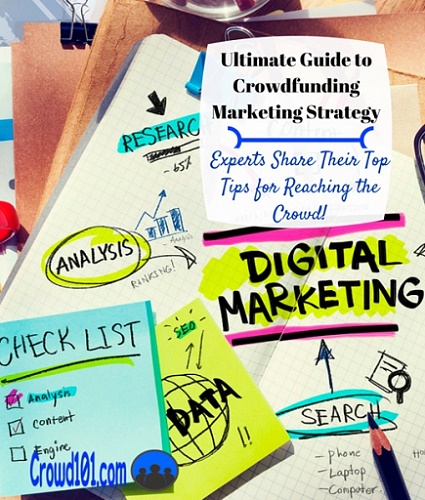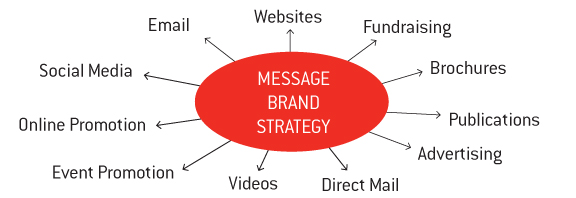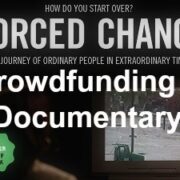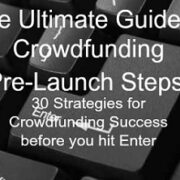Ultimate Guide to Crowdfunding Marketing Strategy
Reach the real crowd in crowdfunding with a crowdfunding marketing strategy and don’t join the 60% of campaigns that fail to reach their funding goal
This post is a follow-up to a post last week on the different resources in crowdfunding campaign marketing and how to get the most bang for your buck. Social media is all the rage and a lot of people spend their entire budget but it’s still some of the old school resources like offline marketing that bring the most supporters to your crowdfunding project.
In this post, I want to wrap-up the topic with insight from seven experts on marketing and share their very best advice on how to get people to your campaign through marketing. Remember, your crowdfunding marketing strategy is the second stage in crowdfunding success.
What to Do Before Crowdfunding Marketing
We’ll get to those great crowdfunding marketing tips in a minute but it’s important that you set the stage for successful marketing before you even hit start on your campaign. Checking some of the boxes below on your crowd campaign will make sure you’re reaching the right people and spending your marketing time effectively.
First you need to define exactly who it is you want to reach with your marketing strategy. This might not necessarily be the same as your customers!
Are your biggest crowdfunding supporters going to be the same as your customers? Maybe, Maybe Not.
So understand exactly who you want to reach with your crowdfunding marketing through developing supporter persona. You can look to similar campaigns for a lot of this research. Even if the campaign owners aren’t willing to share information like demographics and how they connected with supporters, you can get a very good idea of it through the comments left on a campaign.
Once you have an idea of your perfect campaign supporter, you can start to design your marketing strategy with them in mind.
- What are their specific needs and unfulfilled desires that might be satisfied by your crowd campaign?
- What kind of message or messages do you want to get across to potential supporters?
- Write up different material for your marketing, i.e. pdf worksheets, social media quotes, media kit to reach journalists.
- Create a profile on your target social media platforms. Start with Facebook, Twitter, Pinterest and YouTube at a minimum.
Once you have a marketing strategy planned out, you can start reaching out to recruit friends and family. If you don’t already have a group of active supporters for your business, it’s these people from your personal network that will be your first ‘crowd’.
You’ll need to use this mini-crowd to spread your initial message and take it viral to the virtual crowd.
It’s one of the biggest misconceptions in crowdfunding that there is this surge of supporters just waiting to jump at your campaign. There are hundreds of new crowdfunding campaigns uploaded to Kickstarter every day and the only way you’ll get discovered is to prime the pump with your own grass roots effort.
Cash from the Crowd with Viral Marketing
Sally Outlaw provides some great tips from her book Cash from the Crowd on crowdfunding marketing. Sally focuses on three groups that you should approach in your marketing.
- Existing personal network – Sally brings up a good point in contacting your existing network. Don’t send out the same message to everyone. Separate your contacts into lists of friends, family, business and acquaintances. You may be able to use a similar message for everyone on a specific list but you’ll still want to personalize it a little.
- Know the influencers on your list, those people with large social circles (both online and offline). Reach out more personally to them and enlist their help.
- Try asking for advice on your campaign before you go straight into a sales pitch. Talking to your contacts on a personal level first will help gauge their interest in your campaign.
- Social Media followers – Besides your own social media network, look at the network of other businesses or groups related to your campaign. Try contacting the other group to see if you can guest post on their blog or if they can give you a shout out about your blog or campaign. Discover how to best leverage social media to grow your campaign.
- New audiences – Remember that social media isn’t really supposed to be a one-way conversation people use to spam their message, though many only use it for that purpose. You need to be engaging social media followers with questions and a conversation. Only with this engagement will you be able to build a sense of community and convert ‘followers’ to supporters.
A word of warning, the high failure rate on crowdfunding campaigns means an industry has been created that promise to do your crowdfunding marketing for you. Many of these crowdfunding promotion scams will do nothing for your campaign but take your money and waste your time. You are the only person that is going to care enough about your campaign to give it the time it deserves. Learn effective crowdfunding marketing and how to launch a successful crowd campaign.
The Best Crowdfunding Marketing is in Pre-Launch
Chris Dyson of TripleSEO offers a three-phased approach that includes some pre-launch steps.
- Build your Audience encompasses a lot of the pre-launch steps we talked about in the previous posts like understanding who is most likely to support your campaign and building a blog to reach them. Even with more than two billion people online, only a miniscule fraction are going to be interested in your product or social cause. Spending your time or money marketing to the rest is a waste of time. It’s ok though, even the fraction of people that will be interested could be tens of thousands of eager supporters.
- What do your potential supporters do online? Are they on specific blogs or forums?
- Creating a blog is much easier than you probably think. You really only need a few pages that describe your campaign and to which you can post regular updates or thoughts. Chris gets a little detailed with some of his suggestions, diving into what colors represent emotionally, but it’s definitely worth a look for ideas and guidance. Discover how to create a great crowdfunding blog.
- Besides posting something to your blog at least once a week, you need to reach out to other blogs as well. The blogs where your potential supporters hang out already have an audience, why not reach theirs?
- Setting up your Funding Campaign encompasses some of the campaign description and marketing material that will go on your crowdfunding page. This is really still part of your pre-launch stage because you’ll want to test the ideas with friends and family before you put them live on the ‘net.
- Even if your campaign is for a social cause, you’ll want to offer some kind of reward to supporters. If your crowdfunding campaign is to produce a product or business, then you can offer different levels of your product. If your campaign is an emotional plea for a social cause, get creative with your rewards.
- You absolutely must have a video for your campaign, I would recommend a few. Crowdfunding marketing with videos have a much higher success rate and you can use these videos on YouTube as extra marketing.
- Campaign is Live – After your campaign is online, you’ll want to really step it up with your marketing strategy.
- Keep guest posting through the end of your campaign. This is really the best and cheapest way to bring people to your crowdfunding campaign page.
- Keep your community informed through tweets and other social media updates. Reach out personally to the most enthusiastic and see if you can get them to volunteer some time for the campaign
Traffic Tips from a $100,000 Crowdfunding Campaign
 Johnathan Leow draws for the success of the Duet campaign on Indiegogo for his crowdfunding marketing rundown on CrowdfundInsider. The Duet campaign set a goal of just $5,000 which was easily beaten in the first few days of the campaign. It eventually raised more than $100k from 2,752 backers.
Johnathan Leow draws for the success of the Duet campaign on Indiegogo for his crowdfunding marketing rundown on CrowdfundInsider. The Duet campaign set a goal of just $5,000 which was easily beaten in the first few days of the campaign. It eventually raised more than $100k from 2,752 backers.
Building your audience – I feel like a broken record here but the fact is that pre-launch marketing is your number one source for crowdfunding marketing success. Johnathan suggests starting at least five months before your campaign.
This may be tough for a lot of crowdfunders but I would say you need to start at least three months early at a minimum. The article brings up an important point that the crowdfunding platforms like Kickstarter and Indiegogo are traffic amplifiers. If your project is doing well, it may rise in the category rankings or even get featured on the home page, leading to a huge boost in traffic.
- Targeting Customers – Again, you need to know who is most likely to support your campaign. What are their needs and how does your product or service help meet those needs. Resist the urge to point to the most obvious need satisfied by your product. While the most direct need may be helping someone find their phone through an app, the deeper need could be an emotional one like a sense of security and staying connected. Tap into these emotional needs within your marketing.
- Johnathan also recommends a landing page to get people to sign up to an email list. A landing page is basically just a single webpage with one focus, getting people to sign up.
- Stalk your target audience – Ok, you’re not stalking anyone but you definitely need to know where your target audience hangs out and then ‘casually bump into them’. Johnathan shares a cool Google syntax trick to find forums for your niche. In Google search, type:
This will run a search for crowdfunding forums. If your niche is technology applications, you might try forum: tech apps or another search. This will put you in the places where your target audience hangs out. Get active in the forums and get to know some of the people there.
Putting together a Basic Crowdfunding Marketing Strategy
Melinda Emerson offers some basic tips for putting together a crowdfunding marketing strategy from her new book on becoming your own boss.
- Leverage Social Media – Melinda echoes the need to start early with your social media strategy and engage your network. She offers the idea that you should be sharing other people’s content four times as much as your own content.
- Make a Compelling Video – Videos can really distinguish your campaign and drive traffic. I’ve recommended making a series of short videos and posting them on YouTube.
- Make it Easy to Share – Include your social media buttons on all emails and other marketing. Make it easy for people to share your tweets, updates and whatnot with their network.
- Blogger Outreach – Surprised this keeps coming up? Unless your own blog is more than a few months old, you are not going to have much traffic. Go to where the traffic is and guest post or offer to be a reference to other bloggers.
- Your Email List is Key – Another one that keeps coming up in marketing tips and as a blogger, I can vouch that your email list is pure gold. If people are interested enough to subscribe to your email list, they are interested in being a bigger part of your cause.
Social media came up as one of the most often recommended tools in another post on the top tips from campaigns for church fundraising ideas.
8 Crowdfunding Marketing Strategies You Haven’t Heard of
Catherine Clifford outlines eight crowdfunding marketing tips you might not have Heard of before in this post on Entrepreneur. I’ve included some of the more surprising below.
- Researching similar projects is something we talked about in pre-launch steps. Not only will these campaigns help to see what works and what doesn’t from a crowdfunding marketing perspective but the campaign owners might be able to connect you to their own community. Offer something up of your own and people will be quick to share.
- Don’t try to win over everybody – Focus your crowdfunding marketing message on your target audience and their needs. Most successful campaigns have less than 1,000 backers so really speaking to that small market is all you need.
- Set your goal as low as you can manage – Remember, 72% of successful Kickstarter campaigns raise less than $10,000 and well under a percent raise more than $100,000. Consider crowdfunding an initial need that is a part of your overall project. You’re much more likely to raise the smaller amount and you can build on that success in future campaigns.
- Start your tangible rewards at a lower level. Would you donate $10 for just an email reward? Your email “Thank You” reward should go out to smaller contributions like $1 while higher donations should actually get something more.
From the Crowdfunding Marketing Professor
Richard Swart brings up an interesting topic in the need for larger corporate brands to use crowdfunding as a marketing tool. The idea is that not only can you use marketing to drive your crowdfunding campaign but you can also use your crowdfunding campaign to drive marketing. I talked a little about this one in our previous marketing post on the site.
Dodge got more than one million social media mentions for its DodgeDartRegistry campaign. This provided the company with a huge resource of customer data. Your own backer contacts are a priceless source of information. Reach out to every one of your supporters.
- How did they hear about your campaign?
- Which message most stuck out to them and lead them to contribute?
- What is their personal experience with the type of product or cause?
- Are they part of any groups that are related to the type of product or cause?
Even this guide compiled from the advice of seven industry experts cannot cover every marketing strategy or activity. Don’t miss out on your chance to reach the real crowd in crowdfunding through effective crowdfunding marketing. You’ll be able to build a base of supporters that will act as cheerleaders for your business, not only on the current campaign but for every crowd campaign.







